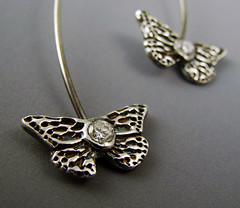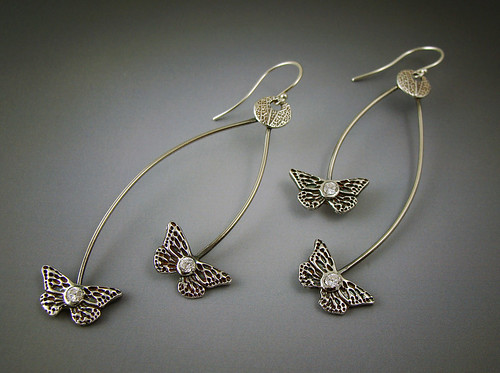Organically Inspired. . .
Search
Butterfly Earrings and the Lessons Learned
 A friend asked me to create a custom pair of earrings for her. She had a pair that she loved, but they were made of cheap materials and were starting to look quite worn, and well, cheap. I didn’t feel comfortable making a direct copy of these earrings, but we talked about how I could interpret the design in fine silver, change things up a bit, and hopefully create a new pair that she would love even more.
A friend asked me to create a custom pair of earrings for her. She had a pair that she loved, but they were made of cheap materials and were starting to look quite worn, and well, cheap. I didn’t feel comfortable making a direct copy of these earrings, but we talked about how I could interpret the design in fine silver, change things up a bit, and hopefully create a new pair that she would love even more.
This design is WAY outside my comfort zone. Seriously, left to my own creative whims, I would never have created something like this. I like the design, it’s just not my style. The good news is that I had to push myself to figure out creative engineering solutions and develop new skills to complete this project. I have a love/hate relationship with custom orders for exactly this reason. I always learn something new, but custom orders frustrate me more than anything else I create.

I thought it would be useful to me (and hopefully to you) to recount the techniques I attempted, the problems I encountered and the lessons I learned along the way.
- My first attempt was to use 16 ga fine silver wire embedded in a pad of wet clay on the backs of the greenware butterflies. I learned two valuable lessons. First, a long stretch of 16 ga fine silver wire will not work harden to my standards of durability. I considered using a heavier fine silver wire, but the wire was just too bulky for the scale of the other elements. Second, if you hit a CZ with a hammer, it will shatter in place and become an instant cloudy mess. Duh!
- My second attempt was to solder argentium wire to the fired butterflies. Through my research, I learned that you can get argentium paste solder, which is useful for ensuring that the solder is as tarnish resistant as the wire. I don’t have much soldering experience, and I apparently got the piece too hot, which once again cracked the cz. I probably could have made this work with practice, but was unsure how many butterflies I might ruin in the process. But, I now have argentium solder in my toolkit whenever I need it in the future.
- The third attempt was the winner. I used argentium wire and embedded them into pads of wet clay on the backs of the greenware butterflies. I had to reduce the firing temperature to accommodate the argentium, but I think it was a good trade off.
- I also got some practice with creating photopolymer plates. I was taught to first create a transparency, then develop the design in TNF (thermo negative film) and then use the TNF to create the photopolymer plate. I think this process was developed because most transparencies don’t come off the printer with rick, dark blacks. Mine tend to be a bit muddy. The TNF creates a nice, crisp black and clear image with really solid blacks. But, in my opinion, the TNF step is a time-consuming pain in the neck. So, I experimented with my butterfly image to see if I could skip the TNF. I printed 2 of the images at exactly the same size, printed them to transparency, and then stacked them up. I had to fiddle with them to get the transparencies perfectly aligned, and then I taped them together. This created a nice, solid image and it created a perfect photopolymer plate. Admittedly, I’m probably not the first person to figure this out, but it was a real “aha” moment for me!
I really hope my friend likes the earrings. I will be very happy to deliver them and cross this project off my list, and I know it will make me smile every time I see her wearing them.






lovely design and good problem solving! i use transparencies doing photosilkscreen with my high school students and find that the old handy-dandy sharpie marker does a great job making the blacks rich and dense on those transparencies….
Good idea, Holly. This design was really tiny and detailed, so I don’t think the sharpie would work in this scenario. But, it’s definitely something to ponder for other projects.
Wow, Wendy! These are really lovely. Nice work!